Content for TS 29.171 Word version: 17.3.0
4 Functional Overview
4.1 General
5 LCS-AP Message Transport
5.1 General
5.2 Protocol Layering
5.3 Usage of SCTP Associations
6 LCS-AP Procedures
6.1 General
6.2 Procedures Applicable to LCS-AP
6.3 Exception Procedures
6.4 Error Handling
4 Functional Overview p. 9
4.1 General p. 9
Figure 4.1-1 below shows the architecture applicable to the positioning of a UE with E-UTRAN access. The SLs interface is used to convey LCS-AP messages and parameters between the MME to the E-SMLC. It is also used for tunnelling LTE Positioning Protocols (LPP between the E-SMLC and the target UE, LPPa between the E-SMLC and the eNB), which are transparent to the MME as described in TS 36.305.
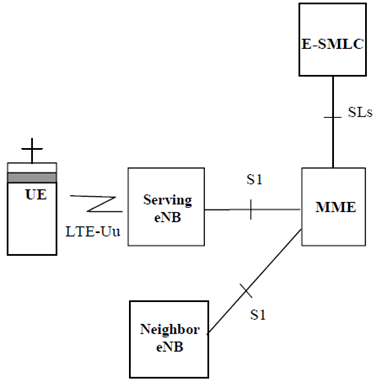
5 LCS-AP Message Transport p. 9
5.1 General p. 9
The LCS-AP is a logical interface between the MME and the E-SMLC. This clause specifies the standards for signaling transport to be used across LCS-AP.
5.2 Protocol Layering p. 9
Figure 5.2-1 below shows the protocol layering used to support the transfer of LCS-AP PDUs between an E-SMLC and a MME. The LTE Positioning Protocols (LPP and LPPa) can be carried in LCS-AP messages which are transparent to the MME.
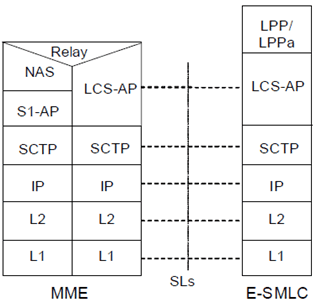
5.3 Usage of SCTP Associations p. 10
SCTP (see RFC 4960) shall be supported as the transport layer of LCS-AP messages.
Semi-permanent SCTP associations shall be established between MME and E-SMLC, i.e. the SCTP associations shall remain up under normal circumstances.
Local multi-homing should be supported. Remote multi-homing shall be supported.
Multiple local SCTP endpoints may be supported. Multiple remote SCTP endpoints shall be supported. When multiple local or remote SCTP endpoints are configured, several simultaneous SCTP associations shall be supported between MME and E-SMLC.
The MME shall establish the SCTP association. Since under normal operation there should always be an SCTP association established between an MME and an E-SMLC, if the E-SMLC needs to initiate a message towards an MME it shall do so over an existing SCTP association already established with that MME.
When an entity detects that an SCTP association has been lost, all resources for transactions open on that association shall be released.
The registered port number for LCS-AP is 9082. The registered payload protocol identifier for LCS-AP is 29.
6 LCS-AP Procedures p. 10
6.1 General p. 10
The LCS-AP interface can be divided into the following procedures:
- Location service request procedure
- Location information exchange procedure
6.2 Procedures Applicable to LCS-AP p. 11
6.2.1 Location Service Request p. 11
6.2.1.1 General p. 11
The purpose of the location service request procedure is to obtain the location estimate for a target UE in E-UTRAN.
6.2.1.2 Successful Operation p. 11
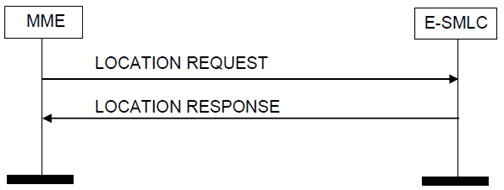
Figure 6.2.1.2-1: Location Service Request Procedure, Successful Operation
(⇒ copy of original 3GPP image)
(⇒ copy of original 3GPP image)
The initiator (MME) of the location service request procedure sends a LCS-AP Location Request message to the E-SMLC associated with the current or last known serving cell for the target UE and starts the timer T3x01. The message contains the following mandatory (M), conditional (C) and optional (O) information, where conditional parameters are required if available.
- Correlation ID (M)
- Location Type (M)
- Cell Identifier (M)
- LCS Client Type (C)
- LCS Priority (C)
- LCS Service Type ID (C)
- LCS QoS (C)
- UE Positioning Capability (O)
- Include Velocity (O)
- IMSI of target UE (O)
- IMEI of target UE (O)
- APDU (O)
- RAT Type (O)
- Coverage Level (O)
- UE Country Determination Indication (O)
- Current geographic location estimate
- Location assistance data for the target UE
- Last known location estimate
- Connection Oriented Information Transfer
- Connectionless Information Transfer
- Correlation ID (M)
- Location Estimate (M).
- Accuracy Fulfilment Indicator (O).
- Velocity estimate (C).
- Positioning Data (C).
- E-UTRAN Cell Identifier (O).
- Cell Portion ID (O).
- Civic Address (O).
- Barometric Pressure (O).
- UE Area Indication (O).
6.2.1.3 Unsuccessful Operation p. 12
If the E-SMLC is unable to obtain any of the location information requested or if requested LCS assistance data could not be transferred, the E-SMLC shall return a LCS-AP Location Response to the initiator of the Location Request carrying the following parameters:
- Correlation ID (M)
- LCS Cause (M)
- Positioning Data (O)
6.2.2 Location Information Exchange p. 13
6.2.2.1 Connection Oriented Information Transfer p. 13
6.2.2.1.1 General p. 13
The Connection Oriented Information transfer procedure enables two-way transfer of LPP and LPPa messages between an E-SMLC and a MME. The procedure is only valid while a location request procedure for the target UE is ongoing. This procedure makes use of the same SCTP association as the location request procedure for the particular target UE.
6.2.2.1.2 Successful Operation p. 13
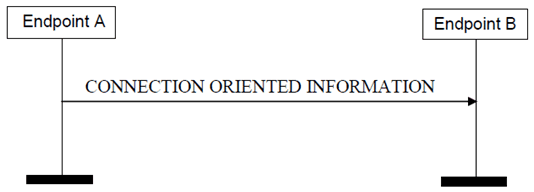
Figure 6.2.2.1.2-1: Connection Oriented Information, Successful Operation
(⇒ copy of original 3GPP image)
(⇒ copy of original 3GPP image)
The initiator of the procedure (E-SMLC or MME) with a LPP or LPPa message to transfer concerning a particular target UE sends a LCS-AP Connection Oriented Information message to a recipient carrying the following parameters:
- Correlation ID (M)
- Payload Type (M)
- APDU (M);
6.2.2.1.3 Abnormal Conditions p. 14
At an intermediate entity, if a received LCS-AP Connection Oriented Information message contains unrecognized information or if the message cannot be sent on, the message shall be discarded.
6.2.2.2 Connectionless Information Transfer p. 14
6.2.2.2.1 General p. 14
The Connectionless Information transfer procedure enables two-way transfer of LPPa messages between an E-SMLC and a MME when there is no existing signalling connection association. This procedure can be used to query eNBs for the information not related to a UE connection, such as Timing information on the eNB.
6.2.2.2.2 Successful Operation p. 14
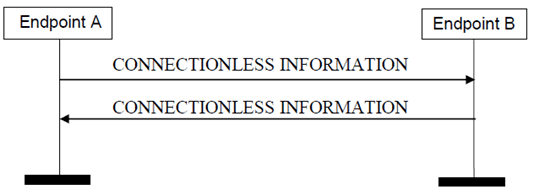
Figure 6.2.2.2.2-1: Connectionless Information Procedure, Successful Operation
(⇒ copy of original 3GPP image)
(⇒ copy of original 3GPP image)
The initiator of the procedure (either E-SMLC or MME) sends a LCS-AP Connectionless Information message to a recipient carrying the following parameters:
- Source Entity (M)
- Destination Entity (M)
- APDU (M)
- Return Error Request (O)
6.2.2.2.3 Unsuccessful Operation p. 14
If the message cannot be transferred by an intermediate entity or destination entity and the Return Error Request is not included, the message shall be discarded. If the Return Error Request is included, the intermediate or destination entity shall, depending on the Return Error Request type, send a LCS-AP Connectionless Information message to, or towards, the original source containing the following parameters:
- Source Entity (M)
- Destination Entity (M)
- APDU (M)
- Return Error Cause (M)
6.2.2.2.4 Abnormal Conditions p. 15
At an intermediate entity, if a received LCS-AP Connectionless Information message contains unrecognized or invalid information, the message shall be discarded.
At the recipient entity, if a received LCS-AP Connectionless Information message contains invalid or unrecognized information as defined for LCS-AP, the message shall be discarded.
6.2.3 Ciphering Keys Delivery |R15| p. 15
6.2.3.1 General p. 15
The purpose of the ciphering keys delivery procedure is to enable the E-SMLC to send ciphering keys for broadcast assistance data to the MME so that the MME can then distribute the ciphering keys to suitably subscribed UEs.
6.2.3.2 Successful Operation p. 15
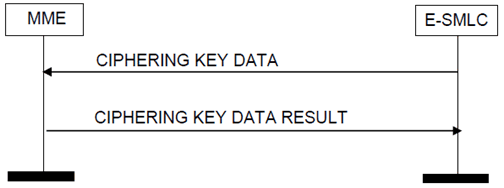
Figure 6.2.3.2-1: Ciphering Keys Delivery Procedure, Successful Operation
(⇒ copy of original 3GPP image)
(⇒ copy of original 3GPP image)
The initiator (E-SMLC) of the ciphering keys delivery procedure sends a Ciphering Key Data message to the MME and starts the timer T3x03. The message contains the following mandatory (M) information:
- Ciphering Data (M):
- Ciphering Data Ack (M)
6.2.3.3 Unsuccessful Operation p. 15
If the MME is unable to successfully store one or more ciphering data sets included in the Ciphering Key Data message, the MME shall return a Ciphering Key Data Result message carrying the following mandatory (M) information:
- Ciphering Data Error Report (M)
6.3 Exception Procedures p. 16
6.3.1 Location Abort p. 16
6.3.1.1 General p. 16
The purpose of the Location Abort procedure is to cancel an ongoing positioning attempt or the request for assistance data. This message can be sent from the MME to the E-SMLC. This procedure makes use of the same SCTP association as the location request procedure for the particular target UE.
6.3.1.2 Normal Operation p. 16
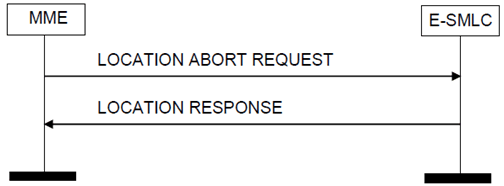
The MME sends a LCS-AP Location Abort Request message to the E-SMLC across the SLs interface. The message contains a LCS Cause parameter indicating the reason of cancellation.
On receipt of this message, the E-SMLC shall stop the positioning transactions of the target UE and may release any resources previously allocated. The E-SMLC shall return a LCS-AP Location Response message containing the LCS Cause received in Location Abort Request and, optionally, positioning data. The E-SMLC may also optionally include in this response any "best-effort" location estimate that it has already determined prior to receiving the LCS-AP Location Abort Request.
6.3.1.3 Abnormal Conditions p. 16
At the recipient entity, if no ongoing location transaction for the target UE is found, the recipient entity shall discard the received LCS-AP Location Abort Request message with no return error message.
6.3.2 Reset p. 16
6.3.2.1 General p. 16
The Reset procedure is an optional procedure applicable to the LCS-AP. It enables an E-SMLC or a MME that has undergone a failure with loss of location service transactions to indicate this to a partner entity. The recipient entity can then release its own connection and transaction resources. The Reset procedure may not be applicable when only a limited part of an E-SMLC or a MME has suffered a failure, since error recovery procedures specific to individual connections and transactions may then be used. The Reset procedure applies to all transactions initiated on a single SCTP association.
6.3.2.2 Normal Operation p. 17
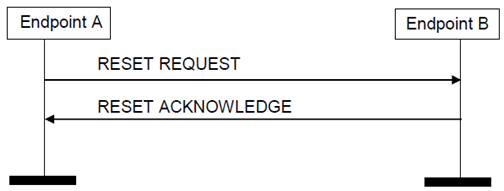
In the event of a failure at an E-SMLC or a MME that results in the loss of location service transactions, a LCS-AP Reset Request message may be sent to the partner entity across the SLs interface. The message contains a LCS Cause parameter indicating the reason for the reset. The sending entity shall ensure that all information on location service transactions for the SCTP association on which the Reset Request was sent is reinitialized to indicate no existing transactions.
On receiving a LCS-AP Reset Request message, the recipient entity (E-SMLC or MME) shall clear all references and state information for the location service transactions on the SCTP association on which the Reset Request was received and shall release any associated resources. The recipient entity shall then return a LCS-AP Reset Acknowledge message using the same SCTP association as the Reset Request.
If the initiating entity (E-SMLC or MME) received the LCS-AP Reset Acknowledge message, it shall stop the timer T3x02.
6.3.2.3 Abnormal Conditions p. 17
On the first expiry of the timer T3x02, the Source entity (E-SMLC or MME) shall resend the LCS-AP Reset Request message and shall reset and restart timer T3x02. This retransmission is repeated a maximum of "n" times, where "n" is an O&M administered parameter. Following "n" unsuccessful reset attempts, the procedure shall be terminated and maintenance shall be informed.
6.4 Error Handling p. 17
6.4.1 Abnormal Conditions p. 17
If an ongoing location request is pre-empted at the initiator by an inter-eNB handover and MME relocation, or if the main signalling link to the target UE is released by the MME, or if a main signalling link failure indicated by the serving eNodeB persists for more than a certain timeout interval or if there is a timeout waiting for the positioning response, or any other abnormal conditions for which the positioning procedure cannot be maintained, the MME shall send a LCS-AP Location Abort message to the E-SMLC to terminate the positioning procedure.
For Intra-MME handovers, the location session between the MME and E-SMLC is not affected. Application layer impacts on these handovers are handled by higher protocol layers.
If the E-SMLC cannot proceed with positioning due to some protocol violation or error condition (e.g. inter-eNB handover), it shall return a LCS-AP Location Response message to the initiator containing a LCS cause and, optionally, positioning data.
6.4.2 Overload p. 17
If an E-SMLC is in overload condition, it may reject a LCS-AP Location Request by returning a LCS-AP Location Response containing a LCS Cause parameter indicating congestion. The initiator of the location requests (i.e. MME) may reduce the frequency of later location requests until rejection due to overload has ceased. In reducing the frequency of location service requests, the MME shall reduce lower priority requests, to zero if necessary, before reducing the frequency of higher priority requests. An E-SMLC shall similarly reject location requests of a lower priority, to zero if necessary, due to overload before rejecting location requests of a higher priority. An E-SMLC in overload condition may optionally employ the following procedures to alleviate overload:
- Allow higher priority location service requests to pre-empt lower priority requests for which location service procedures are already in progress.
- Abort lower priority location service requests already in progress.
- Reduce the supported QoS for lower priority requests for a location estimate - e.g. by reducing accuracy or increasing response time.
- Employ UE based positioning methods, where supported by the target UE and the E-SMLC, rather than UE assisted or network based methods (except TA).